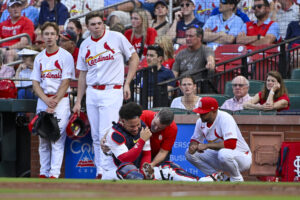After many an article, we have finally reached the top spot on Baseball Reference’s list of great comebacks. The following has to be considered one of the pinnacles of baseball history. Because, in this sport, stating that one has fought back from the brink of disaster is somewhat unique. Comebacks in sports like football and basketball are simple, mainly because opportunities to score are much more plentiful. In baseball, it takes the right amount of momentum, timeliness, and, if we’re brutally honest, sheer luck. Sometimes, the baseball gods smile upon one team and then turn their backs on a dime. This is when comebacks become legendary. Now, we get to bear witness to the most ultimate of these moments.
#1-June 29, 1952: Chicago Cubs vs. Cincinnati Reds
The Anomalous Cubs
The 1952 Chicago Cubs were an anomaly, to say the least. Despite having some of the better statistics, they wound up finishing fifth in the league. Player-manager Phil Cavarretta was certainly not out of options on the field. Offensively, the team placed second in average and first in hits. Catcher Toby Atwell and outfielder Frank Baumholtz each had excellent seasons, with Baumholtz hitting .325. However, it was outfielder and league MVP Hank Sauer who led the bats. His 37 homers, 121 RBI, and 143 OPS+ were enough to carry the team. Add in stellar contributions from the bench, and the recipe for the Cubs’ great offense is complete.
Their pitching was in the same vein. Three of their five starters posted ERA+ numbers above league average. They also gave up 101 home runs, second lowest in the league to the Philadelphia Phillies. Staff ace Bob Rush won 17 games with a 2.70 ERA. He was joined by Warren Hacker (15–9, 2.58 ERA) and Paul Minner (14–9, 3.74 ERA). Closer Dutch Leonard put up an ERA well under 2.50 and an ERA+ of 179. Willie Ramsdell was another bright spot in the bullpen (2.42 ERA, 160 ERA+). So, all in all, not a bad pitching staff. Overall, the Cubs were a very good team, with a few dents. Unfortunately, inconsistency and a lackluster month of July led to their league placement.
The Disappointing Reds
Next, we have the 1952 Cincinnati Reds. This was a team that defined the phrase “managerial revolving door.” Three different men helmed the dugout at one point or another. Luke Sewell, Earle Brucker, and Hall of Famer Rogers Hornsby each took a turn. However, barely any positives were received. The offense was stagnant, with a few exceptions. First baseman Ted Kluszewski was far and away the best bat in the lineup. A .320 average and a 146 OPS+ speak to this. Fellow infielder Bobby Adams led the team with 180 hits. Young outfielder Joe Adcock, far removed from future successes, hit .278 with 13 home runs. Other than that, the offense was mediocre.
Unfortunately, the pitching was much the same. Staff ace Ken Raffensberger did manage his best career year (17–13, 2.81 ERA, 133 ERA+). Second to him was Harry Perkowski (12–10, 3.80 ERA, 98 ERA+). These were the only bright spots in what was an overall sour rotation. Everyone else had ERA’s ranging from 4.34 to 5.38. The bullpen wasn’t much better, although it did boast the best pitcher on the team. His name was Bud Podbielan, who came out of nowhere after being traded from the Brooklyn Dodgers midway through the season. His 2.80 ERA and 134 ERA+ paced his fellow hurlers. Good showings from Joe Nuxhall and closer Frank Smith helped the relief staff some. However, awful performances from others helped sink the relief corps.
The Recipe for Excellent Comebacks
Now that we’ve discerned the players, let’s examine the game itself. It’s definitely an amalgamation of a lot of the parts of a good “comebacks” story. It starts in game one of the teams’ doubleheader. Featured here are the following: a big inning, a back-and-forth affair, and a pitching meltdown of some sort. Once again, as we have learned, these are all essential parts of a perfect affair regarding comebacks. Neither team had much to play for at this point in time, however every victory counts. So it was that they took to Crosley Field in some blistering Cincinnati heat (records state the game time temperature was 97 degrees).
Cavarretta sent young Johnny Klippstein to the mound, while Sewell countered with Bubba Church. Three batters into the game, the Reds’ starter found trouble as Cubs first baseman Dee Fondy socked a solo shot. This put the Reds into an immediate hole, yet they’d climb out in their half of the frame. Center fielder Cal Abrams walked to lead things off, followed up by an Adams double. Abrams was gunned down at the plate, but things didn’t end there. Grady Hatton scratched out a single, scoring Adams and tying the game. Three batters later, Adcock picked up a base knock, scoring Hatton and giving the Reds their first lead.
Cincinnati Runs Off
The Reds would add on in the bottom of the second. Abrams and Adams combined for back-to-back hits off Klippstein. Following this, both starters settled down a bit as five of the next six batters were retired between them. In the top of the fourth, the Cubs crept closer as Atwell picked up a single to score Fondy. Quick outs by Bob Addis and Bill Serena doused that rally, and the Cubs stranded the tying run at first base. Once more, both starters settled in, setting down six of the next seven. It seemed that things, for the most part, were settling down. However, by the bottom of the fifth, the run scoring machine would heat up again.
Klippstein began that inning by allowing base hits to Bob Borkowski and Adams. After Hatton popped out, Kluszewski stood in and roped a single, scoring Borkowski and making it 4–2. This brought on the Cubs’ first pitching change as the typically reliable Ramsdell came on. He got Willard Marshall to ground out, but it came at the cost of another Reds run. Adcock followed that with his second RBI hit of the day, making it 6–2. All of these runs were charged to Klippstein, who left the game with an ugly 5.33 ERA. The Cubs were now firmly behind the metaphorical 8-ball, and time was running out.
Comebacks: Where the Cubs Became Bears
Fast forward to the top of the ninth. The Reds had managed to scratch across two more runs, putting the Cubs down by six. Church was still in the game, and two quick outs seemed to seal the Cubs’ fate. However, a double by Serena and a walk to Roy Smalley proved that there was still fight left. Pinch hitter Gene Hermanski picked up an RBI hit, and Eddie Miksis reached on a ground ball that was booted by new Reds third baseman Eddie Kazak. Smith then came on to pitch, but he hit Hal Jeffcoat and then gave up a two-run single to Fondy. The score was 8–6, and the Cubs were well within striking distance. Sauer brought them closer with a hit to score Jeffcoat, causing Sewell to call upon his ace, Raffensberger in relief.
His first test was Bruce Edwards, pinch hitting for Atwell. Raffensberger intentionally walked him. Considering Edwards was hitting below the Mendoza line, this decision might seem odd. However, Addis, who was on deck, was in the middle of an 0-for-14 stretch. After the walk, he was pulled in favor of pinch hitter Johnny Pramesa. He promptly smacked a base hit, scoring both Sauer and pinch runner Randy Jackson. This gave the Cubs a 9–8 advantage, and all the momentum in the world. Leonard made short work of the Reds in the ninth, scoring the Cubs their 37th victory of the season.
Main Photo:
Embed from Getty Images
Players/Managers Mentioned:
Phil Cavarretta, Toby Atwell, Frank Baumholtz, Hank Sauer, Bob Rush, Warren Hacker, Paul Minner, Dutch Leonard, Willie Ramsdell, Luke Sewell, Earle Brucker, Rogers Hornsby, Ted Kluszewski, Bobby Adams, Joe Adcock, Ken Raffensberger, Harry Perkowski, Bud Podbielan, Joe Nuxhall, Frank Smith, Johnny Klippstein, Bubba Church, Dee Fondy, Cal Abrams, Grady Hatton, Bob Addis, Bill Serena, Bob Borkowski, Roy Smalley, Gene Hermanski, Eddie Miksis, Eddie Kazak, Hal Jeffcoat, Bruce Edwards, Johnny Pramesa, Randy Jackson






